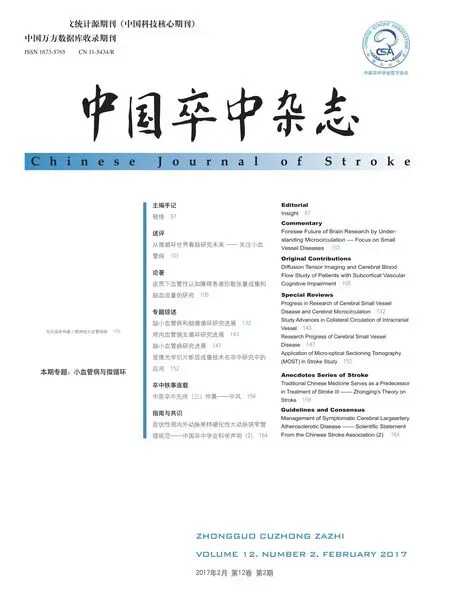脑小血管病研究进展
2018-01-12陶雯柯开富
陶雯,柯开富
脑小血管病(cerebral small vessel disease,CSVD)是指脑内小血管病变导致的疾病,累及的血管直径为30~800 μm,包括发生于小动脉、微动脉、毛细血管和小静脉的疾病。在西方国家CSVD占所有缺血性卒中病因的25%左右[1]。CSVD可引起一系列病理学、神经影像学变化及躯体和认知功能障碍。本文就CSVD病理学、影像学、临床表现及治疗4个方面,对CSVD的研究进展综述如下。
1 CSVD病理改变
欧洲脑小血管病专家组把CSVD分为以下六大类:小动脉硬化性小血管病、散发性或遗传性脑淀粉样血管病、其他遗传性小血管病、炎性或免疫介导性小血管病、静脉胶原化疾病、其他脑小血管病,其中前两种类型最为常见[2]。
1.1 小动脉硬化 也称为年龄和血管危险因素相关性小血管病,病理表现为血管中膜平滑肌细胞缺失,玻璃纤维样物质沉积,管腔狭窄及管壁增厚。此类疾病通常会影响肾脏及视网膜,与高血压关系最为密切,故也称其为高血压性小血管病。
1.2 散发性或遗传性脑淀粉样血管病 脑淀粉样血管病(cerebral amyloid angiopathy,CAA)主要表现βA4免疫反应,淀粉样蛋白逐渐沉积在软脑膜和皮层的小动脉、毛细血管及静脉管壁,使血管壁破坏、血液外溢和管腔闭塞。
1.3 其他遗传性小血管病 主要包括伴有皮质下梗死和白质脑病的常染色体显性遗传性脑小动脉病(cerebral autosome dominant arteriopathy with subcortical infarcts and leukoencephalopathy,CADASIL)及常染色体隐性遗传性脑小动脉病(cerebral autosomal recessive arteriopathy with subcortical infarcts and leukoencephalopathy,CARASIL)、瑞典型遗传性多发性梗死性痴呆、线粒体脑肌病伴高乳酸血症和卒中样发作(mitochondrial myopathy,encephalopathy,lactic acidosis,and stroke-like episodes,MELAS)等,其中CADASIL、Fabry病是遗传性小血管病最常见的类型[3-4],这些类型的出现有助于散发的CSVD的发病机制研究。
1.4 炎性或免疫介导性小血管病 是一组异质性罕见疾病,其特征是血管壁的炎症细胞参与,通常是一种全身性疾病,包括如韦格纳肉芽肿(Wegener’s granulomatosis,WG)、Churg-Strauss综合征、原发性中枢神经系统血管炎、Senddon综合征、系统性红斑狼疮、类风湿关节炎、皮肤炎等。主要病理学改变包括血管壁纤维蛋白坏死,血管周围炎症细胞浸润或纤维化及管腔狭窄。
1.5 静脉胶原化疾病 这类疾病使静脉及其邻近侧脑室旁的小静脉出现病理学改变。这些静脉管壁逐渐增厚,最终使管腔狭窄甚至闭塞。
1.6 其他脑小血管病 包括脑组织放射损伤和阿尔茨海默病(Alzheimer disease,AD)中非淀粉样微血管变性病等。

表1 脑小血管病的动脉病因学分类
2 CSVD神经影像学标记
2013年国际血管改变神经影像标准报告小组(STandards for ReportIng Vascular changes on nEuroimaging,STRIVE)发表了脑小血管病影像学六大标志性表现[5]:新发皮质下小梗死、血管源性腔隙、血管源性脑白质高信号、血管周围间隙(perivascular space,PVS)、脑微出血(cerebral microbleed,CMB)和脑萎缩。见表1。
磁共振成像(magnetic resonance imaging,MRI)作为检测CSVD的重要手段,3T场强MRI已在CSVD的临床诊断中得到广泛运用,但其对CSVD穿支动脉病变的敏感性不高。所以拥有更高的信噪比、空间分辨率等优点的7T场强MRI逐渐进入CSVD诊断领域,并发挥出更加明显的优势。
新发的腔隙性梗死(lacunar infarction,LI)在弥散加权成像(diffusion weighted imaging,DWI)上呈高信号,T1WI呈低信号而T2WI和MRI液体衰减反转恢复(fluid attenuated inversion recovery,FLAIR)像上呈高信号病灶[6],7T场强MRI有更高的信噪比和空间分辨率,可提供更多微细结构信息,故LI更易显像[7]。CMB具备顺磁性,梯度回波序列(gradient-recalled echo,GRE)和磁敏感加权(susceptibility weighted imaging,SWI)序列影像上的小圆形或椭圆形低信号病变[8]。7T场强MRI比1.5T甚至3T MRI对血和铁沉积更为敏感,但也因其“高光溢出效应”更易高估CMB的大小[9]。除此之外,7T场强MRI因其高对比度使PVS范围更加精确[10],其更快的扫描时间也使得脑白质高信号更快被检出[11]。
3 CSVD临床表现
CSVD可引起腔隙性卒中、血管性认知障碍和痴呆、步态异常、头晕、老年抑郁症、帕金森样症状、排尿障碍等多种临床症状,其中前两种临床表现研究较多。腔隙性卒中主要表现为各种腔隙综合征,如感觉运动性卒中、纯感觉性卒中、纯运动性偏瘫、构音障碍手笨拙综合征、共济失调性轻偏瘫等[12]。血管性认知障碍和痴呆起病隐匿且进展缓慢,主要表现为轻微执行能力、反应和处理速度下降[13],其机制是因为与上述功能相关的额叶-皮质下环路受损。CSVD引起的多种病理或影像学改变均可导致血管性认知障碍和痴呆。Koga等[14]发现LI的部位与认知障碍类型有关,LI的数量与认知障碍严重程度成正比;Yakushiji等[15]研究显示CMB也可引起认知功能障碍,并能提升痴呆的发病率。脑白质病变也与血管性认知障碍有密切联系[16],还与步态异常、跌倒、抑郁、尿便障碍等临床表现有关[17]。脑白质病变是CSVD早期预警信号[18]。
4 CSVD的治疗
目前尚未有任何指南对CSVD的诊治进行明确说明,临床上除了对症治疗(排尿障碍等)外,主要防治手段是积极干预其危险因素,药物改善其认知障碍,而对于CSVD所致的卒中与其他病因导致的治疗原则相同。
4.1 危险因素的控制 CSVD是多种危险因素(年龄、性别、高血压、血脂异常、高同型半胱氨酸血症等)作用所致,因此要积极干预危险因素,尤其是高血压的治疗。建议CSVD患者选用减少血压变异性的药物,如长效钙拮抗剂(calcium channel blocker,CCB)和肾素血管紧张素系统(rennin angiotensin system,RAS)阻断剂,因为血压变异性的增高与CSVD进展呈明显相关性,尤其是认知障碍[19],而CCB类药物可以减少患者的血压变异性,RAS阻断剂则可减少体位变化过程中患者的血压变异[20-21]。积极控制血压可预防CSVD患者卒中复发和认知功能衰退[22]。
4.2 卒中治疗 CSVD所致的缺血性卒中与其他病因所致的卒中治疗原则相一致,可采取急性期治疗及二级预防。重组组织型纤溶酶原激活剂(recombinant tissue plasminogen activator,t-PA)是静脉溶栓急性缺血性卒中的有效治疗方法。然而溶栓后出血转化的风险不容忽视。有研究指出,脑白质病变、多发腔隙、CMB是溶栓后出血的独立危险因素[23],但考虑到溶栓的治疗获益,这些因素不作为静脉溶栓治疗的绝对禁忌[24]。二级预防对于CSVD患者同样重要,在抗血小板治疗的药物选择上一般以阿司匹林单药治疗为主,也有研究指出,西洛他唑治疗是更好的选择[25],因其抗血小板及血管扩张作用,对大血管和微血管均有保护,从而增加脑灌注,改善脑白质病变,继而改善脑小血管病所致的认知功能。
4.3 认知功能障碍治疗 抗痴呆药物可对CSVD患者的认知功能发生影响。所以治疗AD或其他类型痴呆的药物如胆碱酯酶抑制剂,可以用于CSVD认知功能障碍的治疗[26-27]。在改善患者认知功能的同时,N-甲基-D-天冬氨酸(N-methyl-D-aspartate,NMDA)受体拮抗剂盐酸美金刚片可以推迟谷氨酸对大脑中枢神经系统毒性损害[28],除此之外,二氢吡啶类钙离子拮抗剂如尼莫地平也能有效延缓认知功能下降[29]。
CSVD发病隐匿且临床表现多种多样不易识别,伴随人口老龄化问题,CSVD导致许多老年人出现认知、精神和肢体功能障碍,发病率呈上升趋势,随着医学诊疗水平的不断发展和人群健康意识的不断提高,早期发现并防治CSVD意义重大。
1 Thompson CS,Hakim AM.Living beyond our physiological means:small vessel disease of the brain is an expression of a systemic failure in arteriolar function:a unifying hypothesis[J].Stroke,2009,40:e322-e330.
2 Pantoni L.Cerebral small vessel disease:from pathogenesis and clinical characteristics to therapeutic challenges[J].Lancet Neurol,2010,9:689-701.
3 Dichgans M.Genetics of ischaemic stroke[J].Lancet Neurol,2007,6:149-161.
4 Ballabio E,Bersano A,Bresolin N,et al.Monogenic vessel diseases related to ischemic stroke:a clinical approach[J].J Cereb Blood Flow Metab,2007,27:1649-1662.
5 Wardlaw JM,Smith EE,Biessels GJ,et al.Neuroimaging standards for research into small vessel disease and its contribution to ageing and neurodegeneration[J].Lancet Neurol,2013,12:822-838.
6 Keir SL,Wardlaw JM,Bastin ME,et al.In which patients is diffusion-weighted magnetic resonance imaging most useful in routine stroke care?[J].J Neuroimaging,2004,14:118-122.
7 Benjamin P,Viessmann O,Mackinnon AD,et al.7 Tesla MRI in cerebral small vessel disease[J].Int J Stroke,2015,10:659-664.
8 Patel B,Markus HS.Magnetic resonance imaging in cerebral small vessel disease and its use as a surrogate disease marker[J].Int J Stroke,2011,6:47-59.
9 van Veluw SJ,Jolink WM,Hendrikse J,et al.Cortical microinfarcts on 7T MRI in patients with spontaneous intracerebral hemorrhage[J].J Cereb Blood Flow Metab,2014,34:1104-1106.
10 Madai VI,von Samson-Himmelstjerna FC,Bauer M,et al.Ultrahigh- field MRI in human ischemic stroke --a 7 tesla study[J].PLoS One,2012,7:e37631.
11 Theysohn JM,Kraff O,Maderwald S,et al.7 tesla MRI of microbleeds and white matter lesions as seen in vascular dementia[J].J Magn Reson Imaging,2011,33:782-791.
12 Sudlow CL,Warlow CP.Comparable studies of the incidence of stroke and its pathological types:results from an international collaboration.International Stroke Incidence Collaboration[J].Stroke,1997,28:491-499.
13 O'Sullivan M,Morris RG,Markus HS.Brief cognitive assessment for patients with cerebral small vessel disease[J].J Neurol Neurosurg Psychiatry,2005,76:1140-1145.
14 Koga H,Takashima Y,Murakawa R,et al.Cognitive consequences of multiple lacunes and leukoaraiosis as vascular cognitive impairment in community-dwelling elderly individuals[J].J Stroke Cerebrovasc Dis,2009,18:32-37.
15 Yakushiji Y,Nishiyama M,Yakushiji S,et al.Brain microbleeds and global cognitive function in adults without neurological disorder[J].Stroke,2008,39:3323-3328.
16 Pantoni L,Poggesi A,Inzitari D.The relation between white-matter lesions and cognition[J].Curr Opin Neurol,2007,20:390-397.
17 LADIS Study Group.2001-2011:a decade of the LADIS (Leukoaraiosis And Disability) Study:what have we learned about white matter changes and smallvessel disease?[J].Cerebrovasc Dis,2011,32:577-588.
18 Jokinen H,Kalska H,Ylikoski R,et al.Longitudinal cognitive decline in subcortical ischemic vascular disease--the LADIS Study[J].Cerebrovasc Dis,2009,27:384-391.
19 Yamaguchi Y,Wada M,Sato H,et al.Impact of ambulatory blood pressure variability on cerebral small vessel disease progression and cognitive decline in community-based elderly Japanese[J].Am J Hypertens,2014,27:1257-1267.
20 Rothwell PM,Howard SC,Dolan E,et al.Effects of beta blockers and calcium-channel blockers on withinindividual variability in blood pressure and risk of stroke[J].Lancet Neurol,2010,9:469-480.
21 Rothwell PM.Limitations of the usual blood-pressure hypothesis and importance of variability,instability,and episodic hypertension[J].Lancet,2010,375:938-948.
22 Gorelick PB,Scuteri A,Black SE,et al.Vascular contributions to cognitive impairment and dementia:a statement for healthcare professionals from the American Heart Association/American Stroke Association[J].Stroke,2011,42:2672-2713.
23 Neumann-Haefelin T,Hoelig S,Berkefeld J,et al.Leukoaraiosis is a risk factor for symptomatic intracerebral hemorrhage after thrombolysis for acute stroke[J].Stroke,2006,37:2463-2466.
24 Pantoni L,Fierini F,Poggesi A.Thrombolysis in acute stroke patients with cerebral small vessel disease[J].Cerebrovasc Dis,2014,37:5-13.
25 Uchiyama S.Results of the Cilostazol Stroke Prevention Study Ⅱ (CSPS Ⅱ):a randomized controlled trial for the comparison of cilostazol and aspirin in stroke patients[J].Rinsho Shinkeigaku,2010,50:832-834.
26 Kavirajan H,Schneider LS.Efficacy and adverse effects of cholinesterase inhibitors and memantine in vascular dementia:a meta-analysis of randomised controlled trials[J].Lancet Neurol,2007,6:782-792.
27 Auchus AP,Brashear HR,Salloway S,et al.Galantamine treatment of vascular dementia:a randomized trial[J].Neurology,2007,69:448-458.
28 Wilcock G,Möbius HJ,Stöffler A.A double-blind,placebo-controlled multicentre study of memantine in mild to moderate vascular dementia (MMM500)[J].Int Clin Psychopharmacol,2002,17:297-305.
29 Pantoni L,del Ser T,Soglian AG,et al.Efficacy and safety of nimodipine in subcortical vascular dementia:a randomized placebo-controlled trial[J].Stroke,2005,36:619-624.
